Population Data#
In this project we want to be able to determine the population density of neighbourhoods, independent of the place. Goal ist to write parametrized code to work globally for any place. But first we need to find out how to work with the data. This is split up into two parts:
Get the boundary for each place and calculate its area.
Find the enclosed population and divide by the area.
On the way, we will also touch upon resampling, raster data, and affine transformations.
As an example, we will use Bogotá, Colombia. First, we need to get the boundary (multi)polygon.
Show code cell source
import io
import zipfile
from os.path import exists, basename
import matplotlib.pyplot as plt
import osmnx as ox
import rasterio
import requests
from matplotlib.colors import SymLogNorm
from rasterio.plot import show
from rasterio.windows import Window
from rasterio.enums import Resampling
from rasterstats import zonal_stats
1. Area Boundary#
bogota_gdf = ox.geocode_to_gdf('Bogotá, Capital District, RAP (Especial) Central, Colombia')
# Project to UTM, so we can treat it as flat Cartesian coordinates (meters)
bogota_gdf = ox.projection.project_gdf(bogota_gdf)
print(f"The area of Bogotá is {round(bogota_gdf.area[0] / 10 ** 6, 2)} km²")
bogota_gdf.explore()
The area of Bogotá is 391.64 km²
2. Population#
For a general solution, we want to be able to query the population dataset (GHS-POP R2023A[1]) for any place. We do not want to load the whole dataset, so we will find out the bounding box of the place and only load the raster data for that area. To get an idea of the dataset structure, the download page has a visualization of the tiling. There is also an Interactive visualisation of the GHS population grid (R2023).
All different GHSL datasets are available on the FTP server
https://jeodpp.jrc.ec.europa.eu/ftp/jrc-opendata/GHSL/
and the 2023 population dataset is in the folder
GHS_POP_GLOBE_R2023A.
The dataset is available in 5-year intervals and in resolutions of 100m, 1km, 3
arcsec, and 30 arcsec. We are interested in the 100m 2025 projection data.
The files are under
/GHS_POP_E2025_GLOBE_R2023A_54009_100/V1-0/tiles/GHS_POP_E2025_GLOBE_R2023A_54009_100_V1_0_R{row}_C{col}.zip,
where row and col are the row and column of the raster tile.
Each tile is 100km x 100km (row 1 to 18, column 1 to 36).
The whole dataset is in World Mollweide (ESRI:54009) projection (with the prime
meridian at Greenwich (EPSG:4326)) for the 100m and 1km resolution, and in WGS84
(EPSG:4326) for the 3 and 30 arcsec resolutions.
Another option is to directly download the whole dataset
/V1-0/GHS_POP_E2025_GLOBE_R2023A_54009_100_V1_0.zip.
In 100m resolution, the file is 4.9 GB (compressed). This way, we do not need to worry
about the tiling.
def get_GHSL_urls(bbox_moll):
"""Get the URLs of the GHSL population raster tiles that contain the
boundary.
100m resolution, 2025 projection, World Mollweide projection.
Parameters
----------
bbox_moll : list
Boundary of the place in Mollweide projection.
[minx, miny, maxx, maxy]
"""
corners = [
(bbox_moll[0], bbox_moll[1]), # southwest
(bbox_moll[0], bbox_moll[3]), # northwest
(bbox_moll[2], bbox_moll[1]), # southeast
(bbox_moll[2], bbox_moll[3]), # northeast
]
# Empty set of URLs
urls = set()
# Check what tile(s) the boundary corners are in
for corner in corners:
# Get the row and column of the tile
row = int((9000000 - corner[1]) / 1e6) + 1
col = min(int((18041000 + corner[0]) / 1e6) + 1, 36)
# Get the URL of the tile
url = (
f"https://jeodpp.jrc.ec.europa.eu/ftp/jrc-opendata/GHSL"
f"/GHS_POP_GLOBE_R2023A/GHS_POP_E2025_GLOBE_R2023A_54009_100/V1-0/tiles/"
f"GHS_POP_E2025_GLOBE_R2023A_54009_100_V1_0_R{row}_C{col}.zip"
)
# Add the URL to the set of URLs
urls.add(url)
return list(urls)
Load the whole tile of Bogotá in 100m resolution to get an idea of the data.
# Project to World Mollweide to get the tile urls
bogota_gdf = bogota_gdf.to_crs("World Mollweide")
bogota_bbox = list(bogota_gdf.bounds.values[0])
bogota_url = get_GHSL_urls(bogota_bbox)
Show code cell source
def download_GHSL(urls):
"""Download the GHSL population raster tile.
Parameters
----------
urls : str or list
URL(s) of the raster tile(s).
Returns
-------
str or list
Path(s) to the downloaded raster tile(s).
"""
files = []
for url in urls if isinstance(urls, (list, tuple)) else [urls]:
# Check if file already exists - same as url but without the path and .tif
if exists(basename(url)[:-4]+".tif"):
files.append(basename(url)[:-4]+".tif")
continue
# Download zip file
r = requests.get(url)
# Unzip to working directory
z = zipfile.ZipFile(io.BytesIO(r.content))
z.extractall() # zip includes tif, meta and data report
# append file ending in .tif from z.namelist()
files.append([f for f in z.namelist() if f.endswith(".tif")][0])
return files[0] if len(files) == 1 else files
Download tile of the data for the area of Bogotá
file_colombia = download_GHSL(urls=bogota_url)
file_colombia
'GHS_POP_E2025_GLOBE_R2023A_54009_100_V1_0_R9_C11.tif'
Windowed Loading#
As we do not want to always load the whole tile, we will load a window of the raster
determined by the bounding box of Bogotá.
Additionally, to that data subset, an affine transformation is needed to
address the coordinates.
The affine transformation is used to transform the raster coordinates to the
projection coordinates, and basically work like a linspace function.
It specifies step length in x and y direction, and the starting point (Northings
and Eastings).
The last column is [0, 0, 1], because there is no rotation. Note that there is also
no shear.
Labelled affine transformation:
Resampling the Population#
In our application, the areas of interests are neighborhoods, the size of the polygons might in some cases be not much larger than the resolution of the raster. The rasterization strategy can be to include all pixels that are fully covered by the polygon, or to include all pixels that are at least partially covered. For a relatively small polygon, there can be a difference in the chosen strategy. Up-scaling the population raster can help to mitigate this.
An illustration of this effect[2]:

A definitive resampling strategy does not exist; the only important consideration is that the sum of the population is conserved. One such approach is to homogeneously distribute the population over the pixels. When splitting each pixel into \(n \times n\) sub-pixels, the population becomes \(P_{\mathrm{new}} = P_{\mathrm{old}} n^{-2}\). The affine transformation also needs to be adjusted.
def resample_load_window(file, resample_factor=1, window=None, res_stategy=Resampling
.average):
"""Load and resample a window of a raster file.
Parameters
-----------
file : str
Path to the raster file. It Can be a tile or the whole raster.
resample_factor : float, optional
Factor to resample the window by. Values > 1 increase the resolution
of the raster, values < 1 decrease the resolution of the raster by that
factor in each dimension.
window : rasterio.windows.Window, optional
Window of the raster to resample, by default None.
res_stategy : rasterio.enums.Resampling, optional
Resampling strategy, by default Resampling.average.
Returns
-------
raster_rescaled : numpy.ndarray
Resampled raster.
res_affine : rasterio.Affine
Affine transformation of the resampled raster.
"""
with rasterio.open(file) as src:
if window is None:
window = src.window(*src.bounds)
# Resample the window
res_window = Window(window.col_off * resample_factor,
window.row_off * resample_factor,
window.width * resample_factor,
window.height * resample_factor)
# Read the raster while resampling
raster_rescaled = src.read(
1,
out_shape=(1, int(res_window.height), int(res_window.width)),
resampling=res_stategy,
window=window,
masked=True,
boundless=True,
fill_value=0,
)
# Affine transformation - respects the resampling
res_affine = src.window_transform(window) * src.transform.scale(1 /
resample_factor)
return raster_rescaled, res_affine
To demonstrate the functionality up until now, we will load the population raster two times. Once the whole raster tile, but downscaled by a factor of 10. We do not need the full resolution for the whole tile, and it would take too long to load. Secondly, we will load a window of the raster, unscaled. The window is determined by the bounding box of Bogotá.
def plot_tile_and_boundary(pop_file, boundary_gdf):
"""Plot the population raster tile and the boundary.
Only works for places in single tile."""
pop_raster_downsampled, affine = resample_load_window(pop_file, 1/10,
res_stategy=Resampling.average)
pop_raster_downsampled = pop_raster_downsampled / (1/10)**2 # for population conservation
fig, axes = plt.subplots(1, 2, figsize=(12, 6), width_ratios=[2, 1])
show(pop_raster_downsampled, ax=axes[0], norm=SymLogNorm(linthresh=5,
linscale=1), transform=affine)
cbar = fig.colorbar(axes[0].get_images()[0], ax=axes[0])
cbar.ax.set_ylabel("Population per pixel")
axes[0].set_title("Population around Bogotá")
# Zoom in to Bogotá - linear scale
with rasterio.open(pop_file) as src:
window = src.window(*boundary_gdf.buffer(1000).total_bounds)
pop_raster_zoom, affine = resample_load_window(pop_file, window=window)
show(pop_raster_zoom, ax=axes[1], transform=affine)
cbar = fig.colorbar(axes[1].get_images()[0], ax=axes[1])
cbar.ax.set_ylabel("Population per pixel")
boundary_gdf.boundary.plot(ax=axes[1], color="white")
axes[1].set_xlim(boundary_gdf.total_bounds[0], boundary_gdf.total_bounds[2])
axes[1].set_ylim(boundary_gdf.total_bounds[1], boundary_gdf.total_bounds[3])
axes[1].set_title("Bogotá, Colombia")
plt.tight_layout()
plt.show()
plot_tile_and_boundary(file_colombia, bogota_gdf)
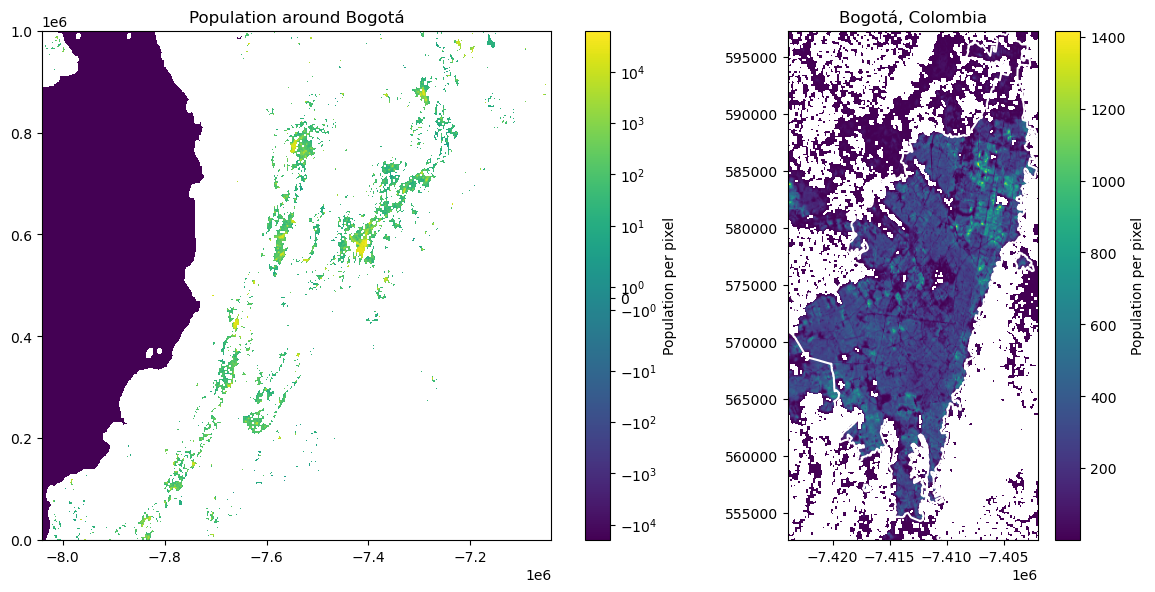
In the whole tile we can see Bogotá as the largest urban area. Other than that, there is Santiago de Cali in the south-west of Bogotá, Medellín in the north-west, and further north-east Bucaramanga, Cúcuta, and San Cristóbal (Venezuela).
Population Summation#
To sum up the population under a polygon, while respecting the population density,
we use the zonal_stats function from the
rasterstats package.
We can use the resample_load_window function to load the raster for the polygon,
possibly upscale, and then use zonal_stats to sum up the population.
resample_factor = 2/1
with rasterio.open(file_colombia) as src:
window = src.window(*bogota_gdf.buffer(100).total_bounds)
pop_raster_zoom, affine_zoom = resample_load_window(
file_colombia,
window=window,
resample_factor=resample_factor,
res_stategy=Resampling.nearest
)
pop_raster_zoom = pop_raster_zoom / resample_factor**2
zs_bogota = zonal_stats(bogota_gdf, pop_raster_zoom, affine=affine_zoom,
stats="sum", nodata=0)
zs_bogota
[{'sum': 9280011.908582615}]
The urban population of Bogotá about 8 million, the metropolitan area has 10 million inhabitants[3]. This is a fitting result.
Finally, we want to write a function that takes a polygon of a place as a GeoDataFrame, the population raster file, and a resample factor, and returns the population of the place.
def get_population(place_gdf, pop_raster_file, resample_factor=1):
"""Get the population for a place.
Parameters
----------
place_gdf : GeoDataFrame
GeoDataFrame of the place.
pop_raster_file : str or list
Path to the population raster file(s).
resample_factor : float, optional
Factor to resample the raster by. The default is 1. Optimally an integer for
up-scaling.
Returns
-------
float
Population of the place.
"""
# Window of place, buffered by 100m
with rasterio.open(file_colombia) as src:
window = src.window(*place_gdf.buffer(100).total_bounds)
# Convert place to raster projection
place_gdf_raster_crs = place_gdf.to_crs(src.crs.data)
# Load population raster
pop_raster, affine = resample_load_window(
pop_raster_file, resample_factor, window=window,
res_stategy=Resampling.nearest if resample_factor >= 1 else Resampling.average)
pop_raster = pop_raster / resample_factor ** 2 # Correct for resampling
# Get population
zs_place = zonal_stats(place_gdf_raster_crs, pop_raster, affine=affine,
stats="sum", nodata=0)
# Plot population raster with place boundary
_, axe = plt.subplots(figsize=(6, 6))
show(pop_raster, ax=axe, transform=affine, norm=SymLogNorm(linthresh=10,
linscale=1))
cbar = plt.colorbar(axe.get_images()[0], ax=axe)
cbar.ax.set_ylabel("Population per pixel")
place_gdf_raster_crs.boundary.plot(ax=axe, color="white")
return zs_place[0]["sum"]
# Get population of Bogotá
get_population(bogota_gdf, file_colombia)
9298558.839112356
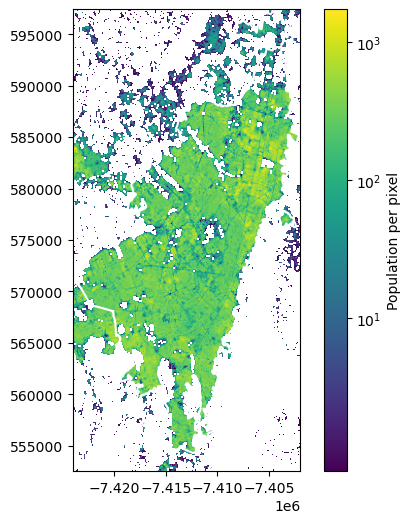
This result differs a bit from the first one, as we do not use resampling in this function. The difference is of numerical nature. For our application with small Superblocks, we need the up-scaling to get good estimates of the population in the Superblocks.
Places on tile edges#
The get_population function works well for places that are fully contained
in one tile. However, for places that are on the edge of a tile, the function
will not work. As a solution, we resort to the simple approach of running the
function for each tile and summing it up.
One such example is the city of Jönköping in Sweden, it falls on two tiles.
Show code cell source
def get_population(
place_gdf, pop_raster_files, resample_factor=1, place_name=None, low_cutoff=0
):
"""Get the population for a place.
Parameters
----------
place_gdf : GeoDataFrame
GeoDataFrame of the place.
pop_raster_files : str or list
Path to the population raster file(s).
resample_factor : float, optional
Factor to resample the raster by. The default is 1. Optimally an integer for
up-scaling.
place_name : str, optional
Name of the place. The default is None.
low_cutoff : float, optional
The least considered value for the population. The default is 0.
Returns
-------
float
Population of the place.
"""
fig, axe = plt.subplots(figsize=(6, 6))
pop_sum = 0
for pop_raster_file in pop_raster_files if isinstance(pop_raster_files, list) else [
pop_raster_files]:
# Window of place, buffered by 100m
with rasterio.open(pop_raster_file) as src:
window = src.window(*place_gdf.buffer(100).total_bounds)
# Convert place to raster projection
place_gdf_raster_crs = place_gdf.to_crs(src.crs.data)
# Cut off window to raster extent - for the case of places on the edge of a tile
window = window.intersection(src.window(*src.bounds))
# Load population raster
pop_raster, affine = resample_load_window(
pop_raster_file, resample_factor, window=window,
res_stategy=Resampling.nearest if resample_factor >= 1 else Resampling.average)
pop_raster = pop_raster / resample_factor ** 2 # Correct for resampling
# Set masked values to 0
pop_raster = pop_raster.filled(0)
# Cut off low values
pop_raster[pop_raster < low_cutoff] = 0
# Get population
zs_place = zonal_stats(place_gdf_raster_crs, pop_raster, affine=affine,
stats="sum", nodata=0)
pop_sum += zs_place[0]["sum"]
# Plot population raster with place boundary
show(pop_raster, ax=axe, transform=affine, norm=SymLogNorm(linthresh=5,
linscale=1))
cbar = plt.colorbar(axe.get_images()[0], ax=axe)
cbar.ax.set_ylabel("Population per pixel")
place_gdf_raster_crs.boundary.plot(ax=axe, color="white")
if place_name:
fig.suptitle(place_name)
# title with population
axe.set_title(f"Population: {pop_sum:.0f}")
plt.tight_layout()
plt.show()
return pop_sum
def get_population_from_query(query):
place_gdf = ox.geocode_to_gdf(query)
place_gdf = place_gdf.to_crs("World Mollweide")
place_url = get_GHSL_urls(list(place_gdf.bounds.values[0]))
files_place = download_GHSL(urls=place_url)
return get_population(place_gdf, files_place, place_name=query)
# Get population of Jönköping
get_population_from_query("Jönköping, Sweden")
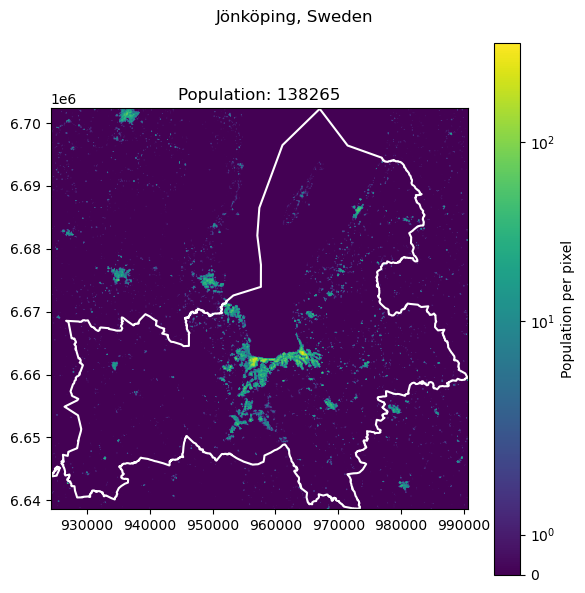
138265.31167728594
To have an example on an intersection of four tiles, we use the city of Pontianak, West Kalimantan, Indonesia.
get_population_from_query("Pontianak, West Kalimantan, Indonesia")
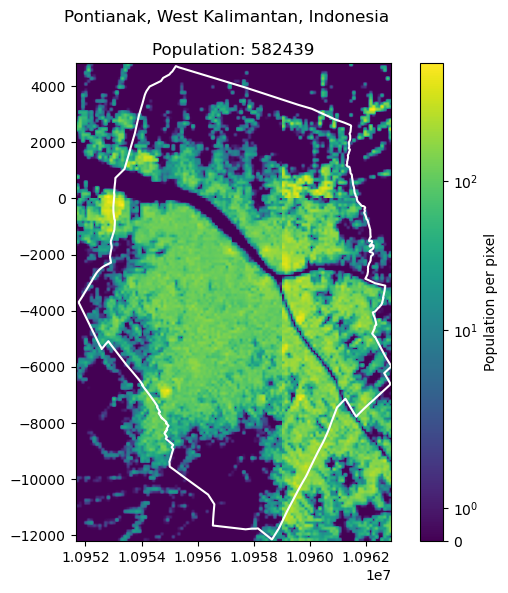
582438.7547574053
Comparison#
To test the approach, we want to compare several places with official population data. Comparison data is taken from the World Population Review, which sources from the United Nations population estimates.
cities = [
["Delhi", "India", 32941308],
["Dhaka", "Bangladesh", 23209616],
["Cairo", "Egypt", 22183200],
["Seoul", "South Korea", 9988049],
["Alexandria", "Egypt", 5588477],
["Ankara", "Turkey", 5397098],
["Kiev", "Ukraine", 3016789],
["Port Au Prince", "Haiti", 2987455],
["Beirut", "Lebanon", 2421354],
["Naples", "Italy", 2179384],
["Frankfurt", "Germany", 796437]
]
for city in cities:
print(f"{city[0]}, {city[1]}: {city[2]}")
try:
city.append(get_population_from_query(f"{city[0]}, {city[1]}"))
# Append relative difference
city.append((city[2] - city[3]) / city[2] * 100)
except:
cities.remove(city)
Delhi, India: 32941308
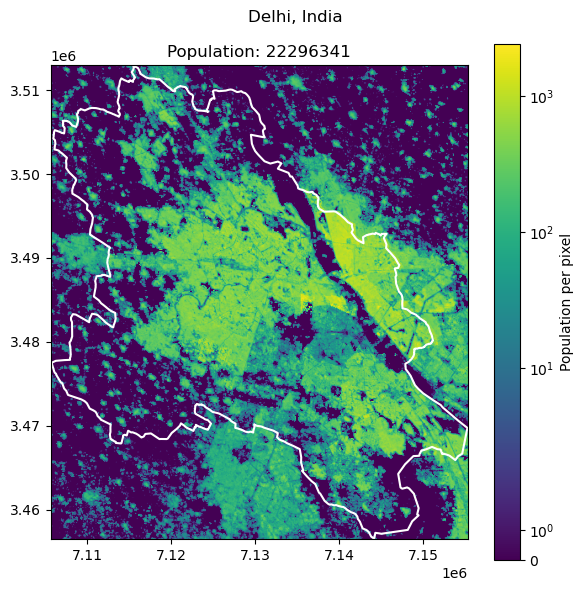
Dhaka, Bangladesh: 23209616
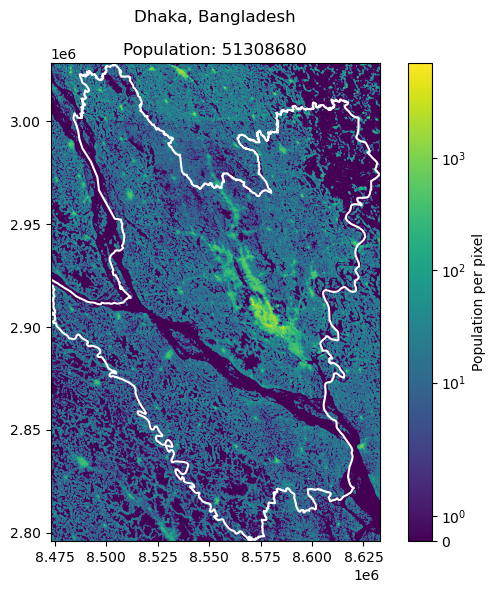
Cairo, Egypt: 22183200
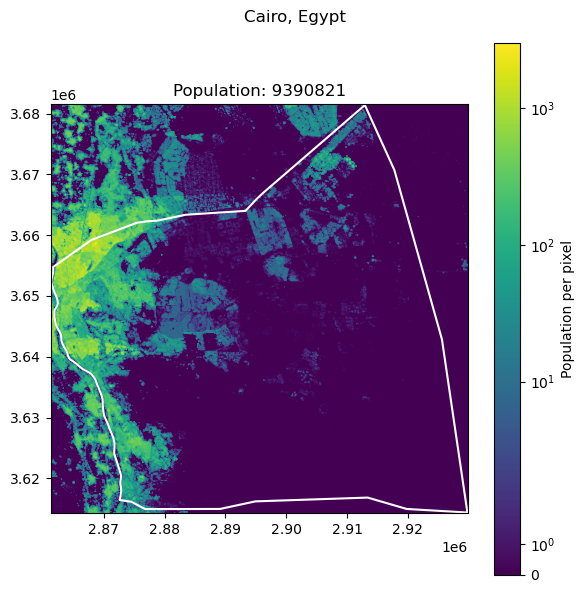
Seoul, South Korea: 9988049
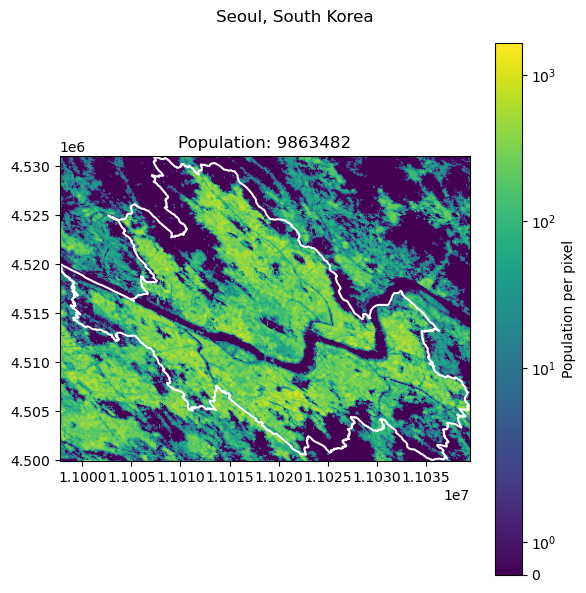
Alexandria, Egypt: 5588477
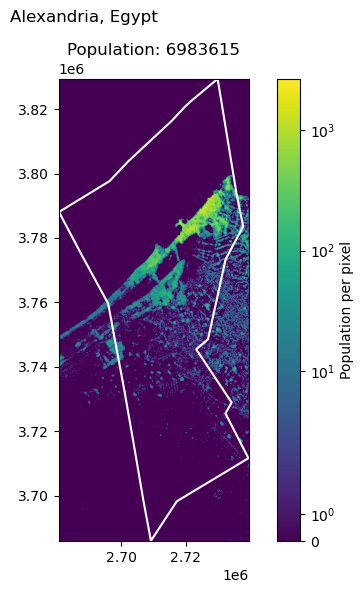
Ankara, Turkey: 5397098
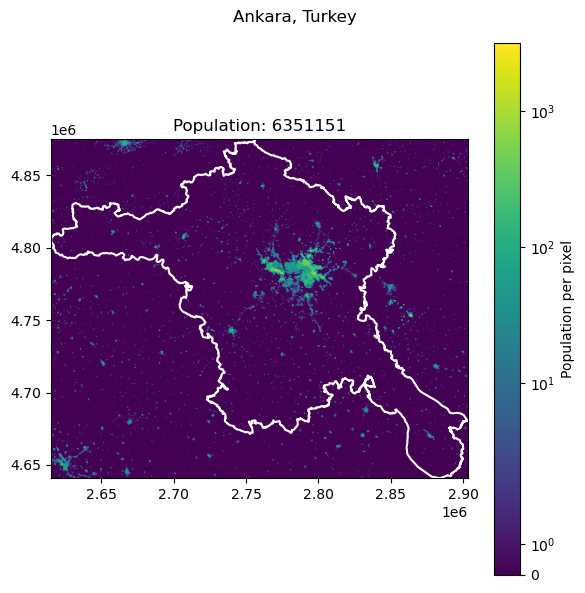
Kiev, Ukraine: 3016789
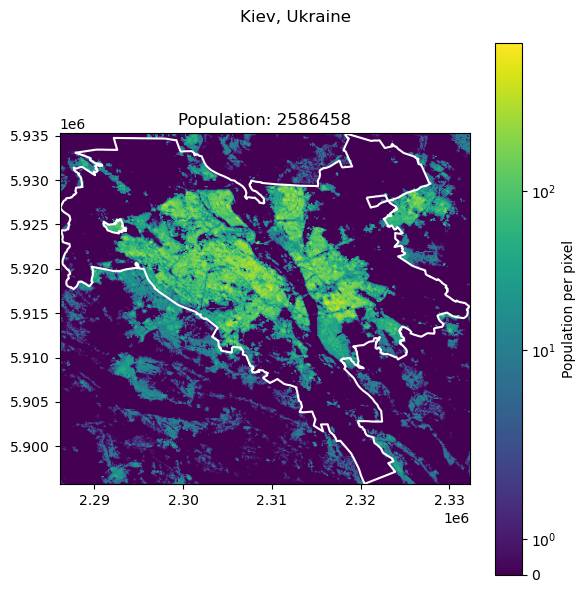
Port Au Prince, Haiti: 2987455
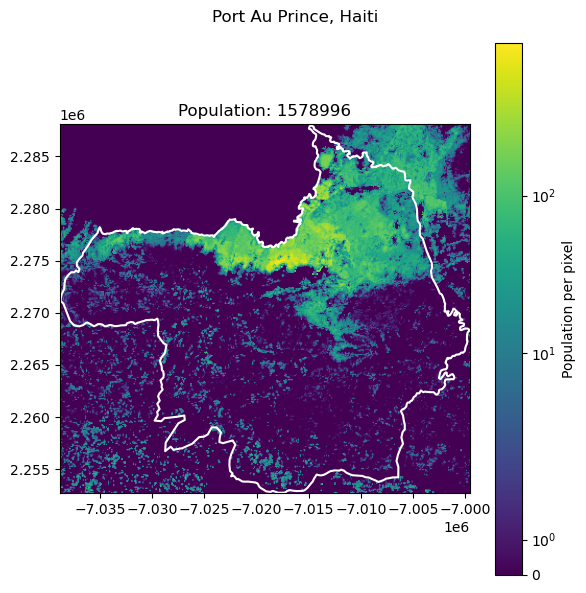
Beirut, Lebanon: 2421354
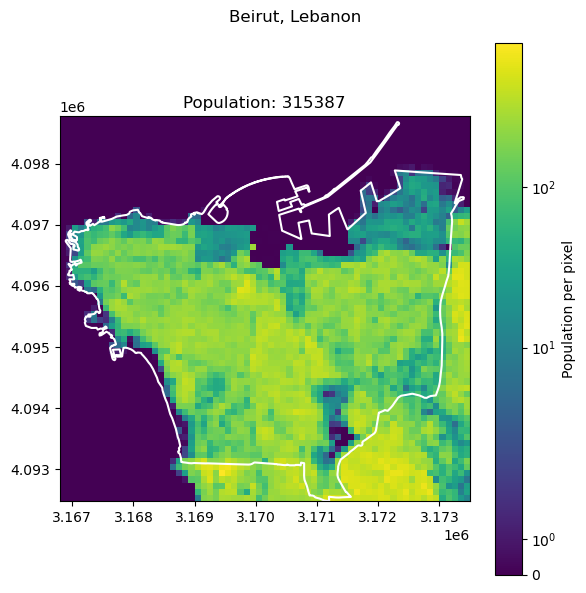
Naples, Italy: 2179384
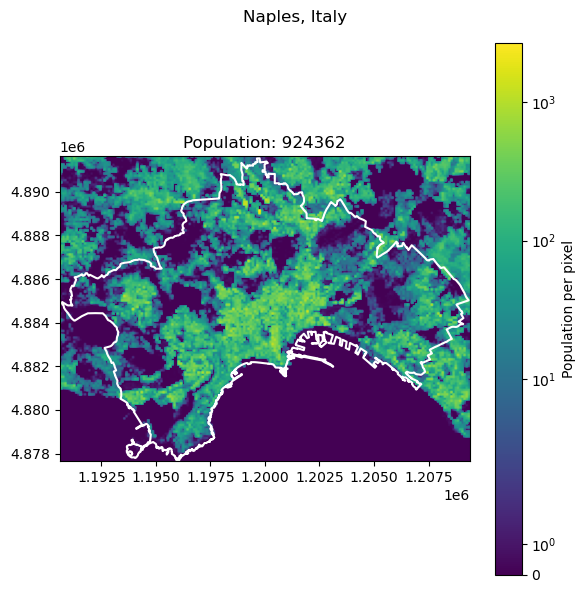
Frankfurt, Germany: 796437
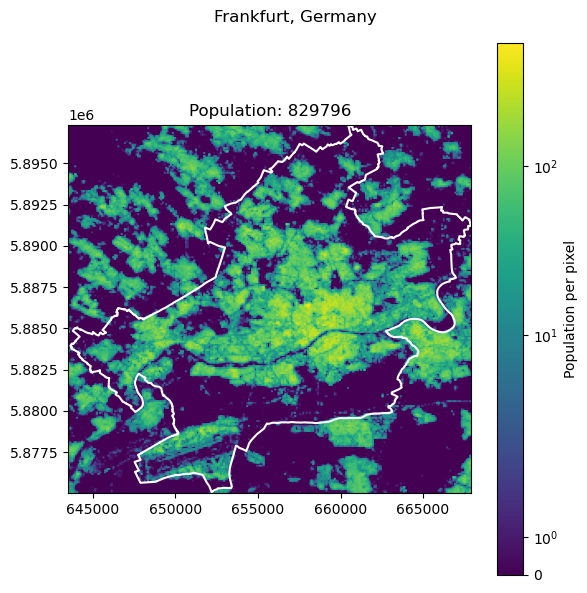
Show code cell source
import pandas as pd
# Sort df after relative difference
df = pd.DataFrame(cities, columns=["city", "country", "population",
"predicted_population", "rel_diff"])
display(df.sort_values(by="rel_diff"))
| city | country | population | predicted_population | rel_diff | |
|---|---|---|---|---|---|
| 1 | Dhaka | Bangladesh | 23209616 | 5.130868e+07 | -121.066477 |
| 4 | Alexandria | Egypt | 5588477 | 6.983615e+06 | -24.964547 |
| 5 | Ankara | Turkey | 5397098 | 6.351151e+06 | -17.677148 |
| 10 | Frankfurt | Germany | 796437 | 8.297957e+05 | -4.188494 |
| 3 | Seoul | South Korea | 9988049 | 9.863482e+06 | 1.247162 |
| 6 | Kiev | Ukraine | 3016789 | 2.586458e+06 | 14.264533 |
| 0 | Delhi | India | 32941308 | 2.229634e+07 | 32.314949 |
| 7 | Port Au Prince | Haiti | 2987455 | 1.578996e+06 | 47.145783 |
| 9 | Naples | Italy | 2179384 | 9.243615e+05 | 57.586110 |
| 2 | Cairo | Egypt | 22183200 | 9.390821e+06 | 57.666968 |
| 8 | Beirut | Lebanon | 2421354 | 3.153866e+05 | 86.974782 |
Show code cell source
plt.scatter(df["population"], df["rel_diff"])
plt.xscale("log")
plt.xlabel("Population")
plt.ylabel("Relative difference to predicition [%]")
plt.grid()
plt.show()
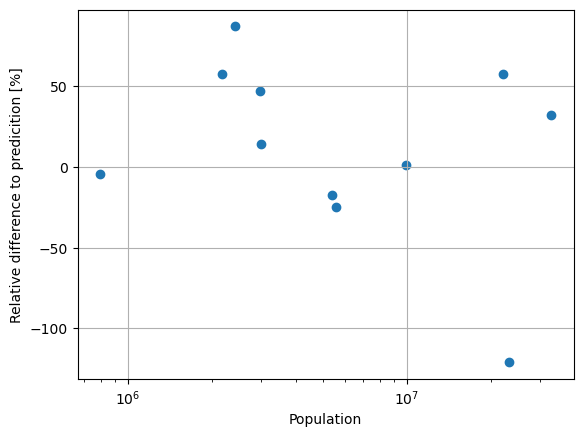
We see clear differences between the predicted and the official population. More importantly, the predictions are always in the same order of magnitude. The differences are due to the difference in character of the data sources. While the official numbers are based on the governmental census, the predictions might use a different border for the city, which is likely to cut off some, or include some rural areas. Regarding this, the result is acceptable, especially with the context that we will use it for small Superblocks and only as a rough approximation of the population and population density.

